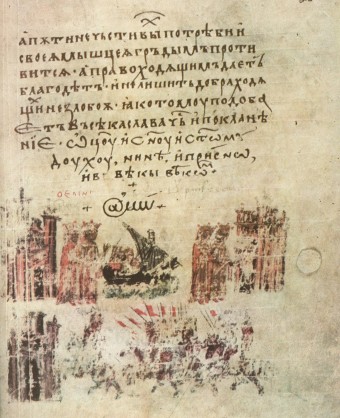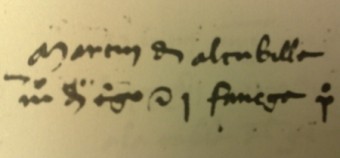The Origin of the @ Symbol and the First Email Message
Ubiquitous today, until its use in email addresses, the @ symbol was never really all that popular, with this very fact being one of the reasons it was chosen to be used in electronic message addresses in the first place. So where did the @ symbol come from?
The earliest known example of @ is found in the 1345 Bulgarian translation of the 12th century Manasses Chronicle, which gives a brief synopsis of the history of the world up to the end of the 11th century. In it, @ was used as the symbol for “amin” (amen). No (presently) known surviving instance of @ occurred again for a little over two centuries.
Seemingly independently “invented,” yet another early example, this time of a proto-@ (with just the outside swoosh, but lacking a defined center a), was used on a 1448 Spanish registry, Taula de Ariza, referencing a shipment of wheat from Castile to Aragon.
The earliest example of a full @ used in such a commercial setting was discovered in 2000 in a letter written by a Florentine merchant, Francesco Lapi, on May 4, 1536. In this letter, Lapi used @ to denote a unit of measure – an amphora (clay jar) of wine, which is equivalent to about 1/13th of a barrel. (See: How Large is a Barrel of Oil and Why Do We Measure It That Way?)
According to professor Giorgio Stabile of Sapienza University of Rome, the discoverer of the letter in question, the flourish around the a for amphora was just one of many examples of such embellishment of script found in Florence at the time.
From here, Dr. Stabile theorized it was Italian merchants who popularized the symbol, with it traveling along with traded goods invoices and receipts throughout Europe.
However, whether it really was the Italians who popularized the symbol isn’t clear. For instance, also during the 16th century the @ symbol in Spain had progressed beyond the aforementioned 1448 proto-@ into the fully developed one, being used as the shorthand symbol for the unit of measure called an arroba, then equivalent to about 25 pounds or 11.3 kg. (The arroba is generally thought to have derived from the Arabic الربع pronounced ar-rub, which meant “a quarter.”)
Whatever the case, from here @ evolved to mean in a commercial setting “at the price of”- i.e. 26 bags of flour @ $1 (so a total of $26 for the purchase). The symbol was also occasionally used in other contexts, such as used to signify the French à at least as early as the 17th century.
It should be noted here that before the discovery of the 1345 and 1536 instances, it was generally thought (and many still posit, including the Oxford English Dictionary) that medieval monks were the ones that invented the symbol to use in place of the Latin ad, which meant at, toward, by and about. Lacking in any hard documented evidence pre-dating the preceding instances, the idea behind this theory is that the simple expedient of combining the two letters (essentially an a with the older ∂ form of the letter d) into a single, smaller mark would have saved time and materials during a period in history where every copy of every book had to be written out by hand.
Many other such shorthand symbols were created for just this reason. For instance, the ampersand (&) is shorthand for the Latin “et,” meaning “and.” Another such classic shorthand was using “X” for “Christ.” The “X” in this case is actually the Greek letter “Chi,” which is short for the Greek![]() , meaning “Christ”. Scholars began using this particular shorthand about a millennium ago.
, meaning “Christ”. Scholars began using this particular shorthand about a millennium ago.
In any event, the @ symbol labored in relative obscurity for several hundred years until one fateful day in 1971. In that year, engineer Ray Tomlinson was implementing his own version of a little program called SNDMSG. SNDMSG ran on the TENEX operating system and was, essentially, just one of many flavors of single-computer email- in other words, an electronic mail system only capable of sending messages from one user to another on the same computer.
While this might seem absurdly useless given the way people often use computers today, back then programs like this were incredibly handy. For instance, the AUTODIN system created in the early 1960s had a facility for sending messages between users and, at its peak, handled nearly 30 million electronic messages per month. MIT’s Compatible Time-Sharing System (CTSS), also created in the 1960s, had a similar system that allowed its numerous users to login from some terminal and, among other things, exchange messages stored on this single machine.
Tomlinson thought it would be interesting to improve SNDMSG such that it could not only be used for sending messages to other users who could login to the same machine, but also be used to send messages from one computer to another via the budding ARPANET. Tomlinson stated he just thought this tweak to SNDMSG “seemed like a neat idea. There was no directive to ‘go forth and invent email’. The ARPANET was a solution looking for a problem. A colleague (Jerry Burchfiel) suggested that I not tell my boss what I had done because email wasn’t in our statement of work. That was really said in jest because we were, after all, investigating ways in which to use the ARPANET.”
While writing the code for this, Tomlinson had to decide how to designate that a message should be sent to another computer on the network, rather than a local account. He fatefully settled on @, a symbol that only made it on the standard keyboard in the first place because of its usage in commerce.
Why did he choose @ over some other symbol? For starters Tomlinson stated, “I looked at the keyboard, and I thought: ‘What can I choose here that won’t be confused with a username?’ If every person had an ‘@’ sign in their name, it wouldn’t work too well. But they didn’t. They did use commas and slashes and brackets.”
That left just a few symbols to choose from that weren’t being commonly used. He noted that, at the time, “The purpose of the at sign (in English) was to indicate a unit price (for example, 10 items @ $1.95).” So,
it made sense. [@] didn’t appear in names so there would be no ambiguity about where the separation between login name and host name occurred… [@] also had no significance in any editors that ran on TENEX. I was later reminded that the Multics time-sharing system used [@] as its line-erase character. This caused a fair amount of grief in that community of users…
The resulting format was loginname@host (and later loginname@host.domain once the DNS system was developed). And so it was that what is generally credited as being the first true network email, at least as we think of it, was sent in late 1971 by Tomlinson.
Of this momentous occasion, Tomlinson said, “The first message was sent between two [DEC-10] machines that were literally side by side. The only physical connection they had (aside from the floor they sat on) was through the ARPANET. I sent a number of test messages to myself from one machine to the other. The test messages were entirely forgettable and I have, therefore, forgotten them. Most likely the first message was QWERTYUIOP or something similar. (Essentially quickly randomly typing gibberish on the keyboard.) When I was satisfied that the program seemed to work, I sent a message to the rest of my group explaining how to send messages over the network. The first use of network email announced its own existence.”
And the rest, as they say, is history.
If you liked this article, you might also enjoy our new popular podcast, The BrainFood Show (iTunes, Spotify, Google Play Music, Feed), as well as:
- Who Really Invented the Internet?
- Who Invented the QWERTY Keyboard?
- The First Website
- Who Invented the Emoticon?
- How “XOXO” Came to Mean “Hugs and Kisses”
Bonus Facts:
- The earliest documented commercial computer spam message is often incorrectly cited as the 1994 “Green Card Spam” incident. However, the actual first documented commercial spam message was for a new model of Digital Equipment Corporation computers and was sent on ARPANET to 393 recipients by Gary Thuerk in 1978. (See: How the Word “Spam” Came to Mean “Junk Message”)
- The famed Green Card Spam incident was sent April 12, 1994 by a husband and wife team of lawyers, Laurance Canter and Martha Siegal. They bulk posted on Usenet newsgroups advertisements for immigration law services. The two defended their actions citing free speech rights. They also later wrote a book titled “How to Make a Fortune on the Information Superhighway,” which encouraged and demonstrated to people how to quickly and freely reach over 30 million users on the Internet by spamming.
- Though not called spam back then, telegraphic spam messages were extremely common in the 19th century in the United States particularly. Western Union allowed telegraphic messages on its network to be sent to multiple destinations. Thus, wealthy American residents tended to get numerous spam messages through telegrams presenting unsolicited investment offers and the like. This wasn’t nearly as much of a problem in Europe due to the fact that telegraphy was regulated by post offices in Europe.
- The “//” forward slashes in any web address actually serve no real purpose according to Web creator Tim Berners-Lee. He only put them in because “it seemed like a good idea at the time.” He wanted a way to separate the part the web server needed to know about, for instance “www.todayifoundout.com,” from the other stuff which is more service oriented. Basically, he didn’t want to have to worry about knowing what service the particular website was using at a particular link when creating a link in a web page. “//” seemed natural, as it would to anyone who’s used Unix based systems. In retrospect though, this was not at all necessary, so the “//” are essentially (and literally) pointless.
- Berners-Lee chose the “#” for separating the main part of a document’s url with the portion that tells what part of the page to go to because in the United States and some other countries, if you want to specify an address of an individual apartment or suite in a building, you classically precede the suite or apartment number with a “#”. So the structure is “street name and number #suite number”- thus “page url #location in page.”
- Most people use the terms “World Wide Web” or just “web” and “internet” interchangeably, but these are two very different things. Simply put, the internet is a global network of networks of computers; the web is one of the many services available on the internet, providing facilities for accessing and connecting documents and other files available on the internet.
- Berners-Lee chose the name “World Wide Web” because he wanted to emphasize that, in this global hypertext system, anything could link to anything else. Alternative names he considered were: “Mine of Information” (Moi); “The Information Mine” (Tim); and “Information Mesh” (which was discarded as it looked too much like “Information Mess”).
| Share the Knowledge! |
|







“@ = Arroba” means “quarter” because it equals a quarter of a “quintal” (58,752 Kg).
Thus an @ (arroba) is about 15 Kg (58,752 / 4 = 14,688) not 11,3 Kg.
@Miko: At the time period in question all sources I could find said it equaled 25 pounds. Today, it’s different, with the value varying in different regions.